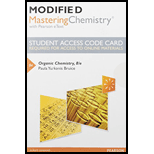
Concept explainers
(a)
Interpretation:
The electrophile reactant and nucleophile reactant in the given reaction has to be indicated.
Concept introduction:
Nucleophiles are the electron rich species and it can share at least a pair of electron. Nucleophiles have negative charge.
Electrophiles are electron deficient species; they look for a pair of electrons. An electrophile has a positive charge, a partial positive charge or an incomplete octet that can accept electron.
(b)
Interpretation:
The electrophile reactant and nucleophile reactant in the given reaction has to be indicated.
Concept introduction:
Nucleophiles are the electron rich species and it can share at least a pair of electron. Nucleophiles have negative charge.
Electrophiles are electron deficient species; they look for a pair of electrons. An electrophile has a positive charge, a partial positive charge or an incomplete octet that can accept electron.
(c)
Interpretation:
The electrophile reactant and nucleophile reactant in the given reaction has to be indicated.
Concept introduction:
Nucleophiles are the electron rich species and it can share at least a pair of electron. Nucleophiles have negative charge.
Electrophiles are electron deficient species; they look for a pair of electrons. An electrophile has a positive charge, a partial positive charge or an incomplete octet that can accept electron.
(d)
Interpretation:
The electrophile reactant and nucleophile reactant in the given reaction has to be indicated.
Concept introduction:
Nucleophiles are the electron rich species and it can share at least a pair of electron. Nucleophiles have negative charge.
Electrophiles are electron deficient species; they look for a pair of electrons. An electrophile has a positive charge, a partial positive charge or an incomplete octet that can accept electron.
Want to see the full answer?
Check out a sample textbook solution
Chapter 5 Solutions
Modified Mastering Chemistry with Pearson eText -- Standalone Access Card -- for Organic Chemistry (8th Edition)
- Label the nucleophile and the electrophile, the nucleophilic atom and the electrophilic atom.arrow_forwarddraw the nucleophile and electrophile precursor for the structures below Azo Dye N `N OH grat Nucleophile Electrophilearrow_forwardPropose an intermolecular interaction that explains how protic solvents affect nucleophiles? Draw an example of this.arrow_forward
- How might nucleophilic catalysis work?Draw out a possible mechanism.arrow_forward1 mol NH3 + 1 mol C2H5Cl when heated there is a lot of unreactd NH3 (about 80%). Why does this occur? How do nucleophiles and electrophiles play a role in this?arrow_forwardWhich of the following species is expected to be found in the tail of the arrow in the reaction mechanism in an organic chemical reaction? * Electrophile Radical Proton Nucleophilearrow_forward
- Label the electrophile and nucleophile in the reaction.arrow_forwardDraw the two reactants used to form the following compound, label the nucleophile and the electrophile, and using arrows show the points of attack of the nucleophile on the electrophile that enables the formation of the heterocyclic product.arrow_forwardWhat reaction category/mechanism type does the following reaction fit? O addition substitution (SN1) substitution (SN2) O elimination (E1) O elimination (E2) HCI CI + HOarrow_forward
 Organic Chemistry: A Guided InquiryChemistryISBN:9780618974122Author:Andrei StraumanisPublisher:Cengage Learning
Organic Chemistry: A Guided InquiryChemistryISBN:9780618974122Author:Andrei StraumanisPublisher:Cengage Learning
 EBK A SMALL SCALE APPROACH TO ORGANIC LChemistryISBN:9781305446021Author:LampmanPublisher:CENGAGE LEARNING - CONSIGNMENT
EBK A SMALL SCALE APPROACH TO ORGANIC LChemistryISBN:9781305446021Author:LampmanPublisher:CENGAGE LEARNING - CONSIGNMENT Chemistry & Chemical ReactivityChemistryISBN:9781133949640Author:John C. Kotz, Paul M. Treichel, John Townsend, David TreichelPublisher:Cengage Learning
Chemistry & Chemical ReactivityChemistryISBN:9781133949640Author:John C. Kotz, Paul M. Treichel, John Townsend, David TreichelPublisher:Cengage Learning



